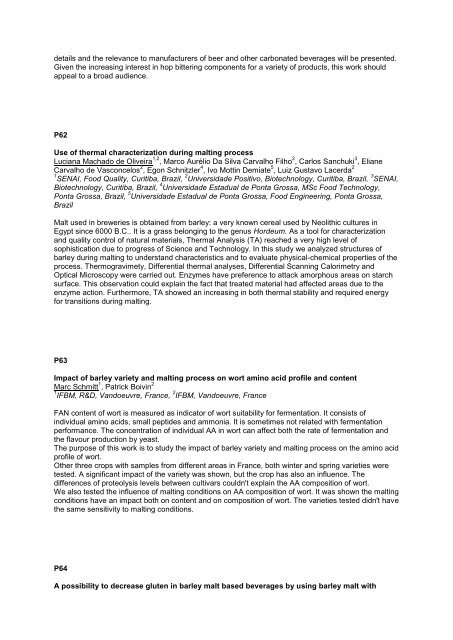here - the 34th European Brewery Convention
here - the 34th European Brewery Convention
here - the 34th European Brewery Convention
Create successful ePaper yourself
Turn your PDF publications into a flip-book with our unique Google optimized e-Paper software.
details and <strong>the</strong> relevance to manufacturers of beer and o<strong>the</strong>r carbonated beverages will be presented.<br />
Given <strong>the</strong> increasing interest in hop bittering components for a variety of products, this work should<br />
appeal to a broad audience.<br />
P62<br />
Use of <strong>the</strong>rmal characterization during malting process<br />
Luciana Machado de Oliveira 1,2 , Marco Aurélio Da Silva Carvalho Filho 2 , Carlos Sanchuki 3 , Eliane<br />
Carvalho de Vasconcelos 2 , Egon Schnitzler 4 , Ivo Mottin Demiate 5 , Luiz Gustavo Lacerda 2<br />
1 SENAI, Food Quality, Curitiba, Brazil, 2 Universidade Positivo, Biotechnology, Curitiba, Brazil, 3 SENAI,<br />
Biotechnology, Curitiba, Brazil, 4 Universidade Estadual de Ponta Grossa, MSc Food Technology,<br />
Ponta Grossa, Brazil, 5 Universidade Estadual de Ponta Grossa, Food Engineering, Ponta Grossa,<br />
Brazil<br />
Malt used in breweries is obtained from barley: a very known cereal used by Neolithic cultures in<br />
Egypt since 6000 B.C.. It is a grass belonging to <strong>the</strong> genus Hordeum. As a tool for characterization<br />
and quality control of natural materials, Thermal Analysis (TA) reached a very high level of<br />
sophistication due to progress of Science and Technology. In this study we analyzed structures of<br />
barley during malting to understand characteristics and to evaluate physical-chemical properties of <strong>the</strong><br />
process. Thermogravimety, Differential <strong>the</strong>rmal analyses, Differential Scanning Calorimetry and<br />
Optical Microscopy were carried out. Enzymes have preference to attack amorphous areas on starch<br />
surface. This observation could explain <strong>the</strong> fact that treated material had affected areas due to <strong>the</strong><br />
enzyme action. Fur<strong>the</strong>rmore, TA showed an increasing in both <strong>the</strong>rmal stability and required energy<br />
for transitions during malting.<br />
P63<br />
Impact of barley variety and malting process on wort amino acid profile and content<br />
Marc Schmitt 1 , Patrick Boivin 2<br />
1 IFBM, R&D, Vandoeuvre, France, 2 IFBM, Vandoeuvre, France<br />
FAN content of wort is measured as indicator of wort suitability for fermentation. It consists of<br />
individual amino acids, small peptides and ammonia. It is sometimes not related with fermentation<br />
performance. The concentration of individual AA in wort can affect both <strong>the</strong> rate of fermentation and<br />
<strong>the</strong> flavour production by yeast.<br />
The purpose of this work is to study <strong>the</strong> impact of barley variety and malting process on <strong>the</strong> amino acid<br />
profile of wort.<br />
O<strong>the</strong>r three crops with samples from different areas in France, both winter and spring varieties were<br />
tested. A significant impact of <strong>the</strong> variety was shown, but <strong>the</strong> crop has also an influence. The<br />
differences of proteolysis levels between cultivars couldn't explain <strong>the</strong> AA composition of wort.<br />
We also tested <strong>the</strong> influence of malting conditions on AA composition of wort. It was shown <strong>the</strong> malting<br />
conditions have an impact both on content and on composition of wort. The varieties tested didn't have<br />
<strong>the</strong> same sensitivity to malting conditions.<br />
P64<br />
A possibility to decrease gluten in barley malt based beverages by using barley malt with





